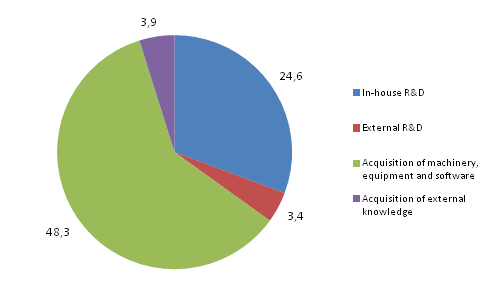6. Innovation activity in human health and social work activities 2008–2010
On the average, enterprises in human health and social work activities engaged in innovation activity related to products and processes as frequently as enterprises in other industries between 2008 and 2010. A total of 44 per cent of enterprises engaged in innovation activity.
A total of 28 per cent of enterprises brought product innovations on the market between 2008 and 2010. The majority of innovating enterprises only reported service innovations. The turnover from innovations launched on the market between 2008 and 2010 accounted for around 10 per cent of the total turnover of enterprises in human health and social work activities in 2010.
The share of enterprises having adopted process innovations was 31 per cent. Enterprises most commonly reported innovative supporting activities related to processes.
Eighty-two per cent of the enterprises in human health and social work activities that had developed products and processes had engaged in or outsourced research and development activity. For instance, procurement of competence and training related to innovation activity was reported more commonly in human health and social work activities than in other industries on the average.
The enterprises reported having spent a total of EUR 80 million on innovation activity in 2010. The share of human health services was 90 per cent of this.Innovation expenditure in human health and social work activities 2010, EUR million

Between 2008 and 2010, a total of 17 per cent of the enterprises in human health and social work activities that had developed products and processes received public funding for their innovation activity. Ten per cent received funding from local or regional authorities, and another 10 per cent received State funding. Three per cent received funding from the EU.
As in other industries, the most important source of information for innovation activity in human health and social work activities is the enterprise or the group itself. Universities and public and private non-profit research institutes were named as the least important information sources in the survey.
For group enterprises, the other enterprises within the group are important partners. For enterprises in human health and social work activities, customers and equipment suppliers are also important partners. The public sector is viewed as an important point of reference and a key partner by many enterprises.
The lack of their own funding and the high expenditure required for innovation activity are great challenges to enterprises engaged in innovation activity related to product and process innovations. The lack of qualified personnel and particularly the uncertainty in the demand for innovative products are obstacles to innovation activity. The main reason for not engaging in innovation between 2008 and 2010 was that the enterprise regarded no new innovations necessary thanks to its previous innovations.
In human health and social work activities, the percentage of enterprises reporting marketing and organisation innovations between 2008 and 2010 was higher than in the other industries on the average, or a total of 48 per cent of enterprises. The share of enterprises having adopted organisational innovations was 40 per cent, and a total of twenty-nine per cent of enterprises had made marketing reforms. A total of 57 per cent of the surveyed enterprises in human health and social work activities had engaged in broadly defined innovation activity.
It was quite common for the enterprises that had engaged in innovation activity to report integration of users and user information in their development work. Enterprises in human health and social work activities exploited customer feedback systems more actively than enterprises in other industries. In other respects, the adoption of user orientation seemed, on the average, similar to other industries.
Source: Innovation 2010, Statistics Finland
Inquiries: Mervi Niemi 09 1734 3263, tiede.teknologia@stat.fi
Director in charge: Leena Storg�rds
Updated 7.6.2012
Official Statistics of Finland (OSF):
Innovation [e-publication].
ISSN=1797-4399. 2010,
6. Innovation activity in human health and social work activities 2008–2010
. Helsinki: Statistics Finland [referred: 20.4.2025].
Access method: http://stat.fi/til/inn/2010/inn_2010_2012-06-07_kat_006_en.html

